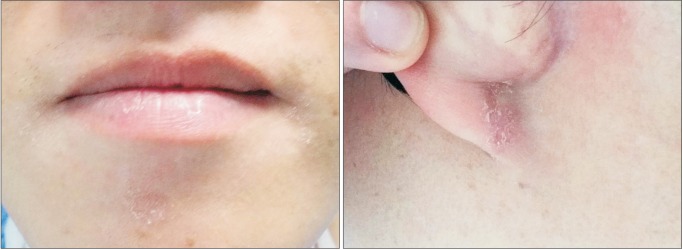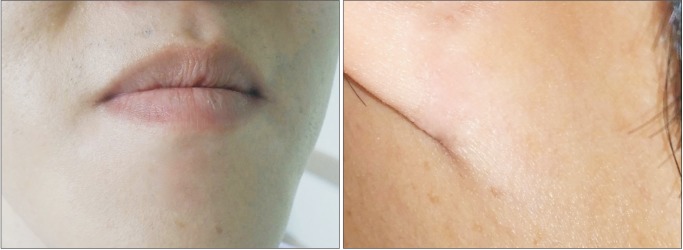Abstract
Seborrheic dermatitis is a chronic recurrent inflammatory disorder presumed to be caused by increased sebaceous gland secretion, metabolic changes in the cutaneous microflora, and changes in the host immune function. Stellate ganglion block (SGB) is known to increase the blood flow rate without altering the blood pressure, heart rate, or cardiac output, to stabilize hypertonic conditions of the sympathetic nerves, and to affect the endocrine and immune systems. It is used in the differential diagnosis and treatment of autonomic nervous system disorders of the head, neck, and upper limbs. The authors report the first case of successful treatment of a patient with seborrheic dermatitis through repeated SGB trials.
Keywords: Nerve block, Seborrheic dermatitis, Stellate ganglion
Seborrheic dermatitis is a chronic recurrent inflammatory disorder characterized by hyperkeratosis, acanthosis, accentuated rete ridges, focal spongiosis, and parakeratosis. It is usually caused by increased sebaceous gland activity, and manifests itself through the apparition of ill-defined eryhematous patches accompanied by fine scaling in areas of high sebum secretion, including the scalp, face, eyebrows, nasal alar creases, melolabial folds, ears, central chest, and genital region. Although the fundamental cause of seborrheic dermatitis has not yet been established, many etiologic factors are believed to play a role in the development of the disorder. In particular, increased sebaceous gland secretions, metabolic changes in the cutaneous microflora, and host immune function changes are considered some of the major causes [1]. According to Uchida et al. [2], stellate ganglion block (SGB) is effective in the treatment of skin disorders of the head and neck. According to the authors, this treatment mechanism maintains the homeostasis of hormones by improving the blood flow in the brain. There has been a report of successful treatment of acne vulgaris — which has a similar etiology to seborrheic dermatitis — with SGB [3]. Therefore, we predicted that SGB would also be effective in the treatment of seborrheic dermatitis. Indeed, repeated SGB trials on a patient who had previously undergone unsuccessful dermatologic treatments were effective. This was the first case of seborrheic dermatitis treatment with SGB.
Case Report
A 31-year-old male patient (height 173 cm, weight 70 kg) with no medical history of particular significance had been receiving treatment at a dermatology clinic for ten years for erythematous patches accompanied by non-painful itching in both nasal alar creases, both perioral areas, and both posterior auricular folds (Fig. 1). A topical steroid treatment was chosen, as he had tested negative on the KOH test. The steroid treatment alleviated the symptoms but could not eliminate them completely. It was notable that even on the steroid treatment, skin lesions appeared when he consumed alcohol or was dehydrated. The patient was on the topical steroid treatment when he visited our hospital, and erythematous patches were visible in the nasal alar creases and perioral areas. As a previous study had reported a case of acne vulgaris treatment with SGB [3], and the mechanisms of acne vulgaris and seborrheic dermatitis are presumed to be similar, we determined to use SGBs on this patient. An anterior blind approach was selected. The patient was positioned with the anterior spine extended, so that the transverse process of the C6 vertebra (Chassaignac's tubercle) could be easily detected. A needle was vertically inserted at the anterior tubercle and was placed on the transverse process. Five ml of 1% mepivacaine were injected after fixing the needle in position and confirming that there were no abnormal sensations in the upper limb or blood aspiration [4]. The same procedure was performed daily, on one side each day. After administration of the injection on one side, ipsilateral ptosis and nasal obstruction occurred but faded about two hours later. The skin lesions disappeared within three days, after which the patient wished to stop the treatment for personal reasons. However, the patient revisited the hospital two months later due to a relapse. During the follow-up, the patient noted that there had been no symptoms up to one week before the revisit. We initiated the same treatment procedure and the patient's skin lesions disappeared after five trials (Fig. 2). Fifty more trials were performed, and the patient has not seen a relapse of the symptoms or side effects since.
Fig. 1. Photo of patient before treatment. Erythematous patches were visible in the perioral areas and posterior auricular folds.
Fig. 2. Photo of patient after treatment. Patient's skin lesions disappeared.
Discussion
Although the fundamental cause of seborrheic dermatitis has not yet been identified, increased sebaceous gland secretions, the proliferation of Malassezia spp, M. globose, and M. restricta and subsequent inflammation increase, as well as changes in the host immune function, are presumed to be some of the major causes. M. globosa and M. restricta break down the lipids in the sebum to form free fatty acids and triglycerides. The resulting unsaturated fatty acids can penetrate the skin and induce inflammation. Moreover, increased amounts of natural killer cells (NK1+), CD16+ cells, and inflammatory interleukins, as well as the proliferation of complements — which come as a result of changes in the host immune function — are clearly visible in the skin lesions. In general, multiple topical therapies (antifungal shampoo, corticosteroid cream, antifungal cream) are used as a treatment to eliminate the cause and to improve the symptoms [1].
Stellate ganglion is also called cervicothoracic sympathetic ganglion; it is located on the first anterior rib or the anterior tubercle of the C7 transverse process [4]. The sympathetic fibers of the lower face, cervical, and upper limbs cross the stellate ganglion; therefore, these fibers can be blocked with SGB. SGB is used in the differential diagnosis and treatment of autonomous nervous system disorders of the head, neck, and upper limbs. SGB increases the blood flow rate without altering the blood pressure, heart rate, and cardiac output [5,6], and stabilizes hypertonic conditions of the sympathetic nerves, thereby blocking the pain associated with visceral afferents [7,8]. It is also known to affect the endocrine and immune systems [2].
A previous study reported that SGBs reduce inflammatory reactions. In the same study, a skin biopsy performed on a seborrheic dermatitis patient's lesion revealed increased counts of inflammatory mediators (interleukin-1, [IL-1], IL-2, IL-4, IL-6, IL-10, IL-12, gamma interferon, TNF-a)[9]. Liu et al. [10] conducted a study on severe trauma patients and reported that the concentrations of IL-b, IL-6, and TNF-a decreased 24 to 72 hours after a SGB. Park et al. [3] successfully treated an acne vulgaris patient with over 50 trials of SGB, and Wajima et al. [11] reported that SGB decreases the levels of serum IgE and eosinophil in atopic dermatitis. These results indicate that SGB is effective in reducing hyper inflammations caused by seborrheic dermatitis, and thus in mitigating the related symptoms. According to a previous study by Wakusugi [12], SGB improves the blood flow in the brain and influences hormone secretions, effectively improving the symptoms of diseases responsive to steroids; hence, SGB can also be applied to seborrheic dermatitis.
Furthermore, SGB affects the neural and immune systems. The sympathetic nervous system, which stems from the nucleus ceruleus of the brainstem, plays an important role in the neural and immune systems. The post-ganglionic sympathetic nerves, which travel along the paravertebral ganglia and prevertebral ganglia, release norepinephrine into various tissues. The concentrations of brain norepinephrine and serum cortisol are proportionately raised to maintain the reflex circuit of the hypothalamus-pituitary-adrenal and sympathetic nerve systems. Under physiological conditions, the immune organs are innervated by the sympathetic nerves, and adrenergic receptors are expressed on the surface of most granulocytes. Therefore, sympathetic nerve activities strongly affect the immune functions [13]. SGBs regulate the neuroendocrine-immune network and restore homeostasis within the body by blocking the sympathetic nervous system. This in turn is presumed to contribute to the restoration of unbalanced statuses, such as seborrheic dermatitis. From a different perspective, Uchida et al. [2] suggested that a chronic increase in sympathetic tone undermines the pinealocyte functions. Subsequently, the plasma melatonin level is reduced, resulting in sleep deprivation, which in turn causes an increase in sympathetic tone. SGBs block this sympathetic cycle and restore a normal melatonin rhythm, ultimately helping patients to maintain a normal sympathetic tone. This restoration of a normal rhythm also contributes to the effective regulation of the neuroendocrine-immune network.
In conclusion, seborrheic dermatitis patients are treated with antifungals and steroids. In cases in which the patients are unresponsive to these traditional treatment modalities, SGBs can be useful. SGBs can also be useful in the treatment of other cutaneous disorders with similar mechanisms.
Acknowledgments
This work was supported by Inha University.
References
- 1.Del Rosso JQ. Adult seborrheic dermatitis: a status report on practical topical management. J Clin Aesthet Dermatol. 2011;4:32–38. [PMC free article] [PubMed] [Google Scholar]
- 2.Uchida K, Tateda T, Hino H. Novel mechanism of action hypothesized for stellate ganglion block related to melatonin. Med Hypotheses. 2002;59:446–449. doi: 10.1016/s0306-9877(02)00158-5. [DOI] [PubMed] [Google Scholar]
- 3.Park JG, Cha DC, Lee SK, Cha YD. Effect of a stellate ganglion block on acne vulgaris: a case report. Korean J Anesthesiol. 2001;41:500–502. [Google Scholar]
- 4.Elias M. Cervical sympathetic and stellate ganglion blocks. Pain Physician. 2000;3:294–304. [PubMed] [Google Scholar]
- 5.Gupta MM, Bithal PK, Dash HH, Chaturvedi A, Mahajan RP. Effects of stellate ganglion block on cerebral haemodynamics as assessed by transcranial Doppler ultrasonography. Br J Anaesth. 2005;95:669–673. doi: 10.1093/bja/aei230. [DOI] [PubMed] [Google Scholar]
- 6.Naidu RK. Review of the stellate ganglion block/cervical sympathetic block on the prevention and therapy of cerebral vasospasm after subarachnoid hemorrhage. ICU Dir. 2013;4:161–165. [Google Scholar]
- 7.McDonnell JG, Finnerty O, Laffey JG. Stellate ganglion blockade for analgesia following upper limb surgery. Anaesthesia. 2011;66:611–614. doi: 10.1111/j.1365-2044.2011.06626.x. [DOI] [PubMed] [Google Scholar]
- 8.Shanthanna H. Utility of stellate ganglion block in atypical facial pain: a case report and consideration of its possible mechanisms. Case Rep Med. 2013;2013:293826. doi: 10.1155/2013/293826. [DOI] [PMC free article] [PubMed] [Google Scholar]
- 9.Gaitanis G, Magiatis P, Hantschke M, Bassukas ID, Velegraki A. The Malassezia genus in skin and systemic diseases. Clin Microbiol Rev. 2012;25:106–141. doi: 10.1128/CMR.00021-11. [DOI] [PMC free article] [PubMed] [Google Scholar]
- 10.Liu MH, Tian J, Su YP, Wang T, Xiang Q, Wen L. Cervical sympathetic block regulates early systemic inflammatory response in severe trauma patients. Med Sci Monit. 2013;19:194–201. doi: 10.12659/MSM.883833. [DOI] [PMC free article] [PubMed] [Google Scholar]
- 11.Wajima Z, Harada S, Nakajima Y, Shitara T, Kobayashi N, Kadotani H, et al. A case of atopic dermatitis treated with stellate ganglion block--the change of serum IgE and blood eosinophil levels. Masui. 1995;44:1135–1138. [PubMed] [Google Scholar]
- 12.Wakusugi B. New application of stellate ganglion block. J Korean Pain Soc. 1991;4:1–7. [Google Scholar]
- 13.Bellinger DL, Millar BA, Perez S, Carter J, Wood C, ThyagaRajan S, et al. Sympathetic modulation of immunity: relevance to disease. Cell Immunol. 2008;252:27–56. doi: 10.1016/j.cellimm.2007.09.005. [DOI] [PMC free article] [PubMed] [Google Scholar]




